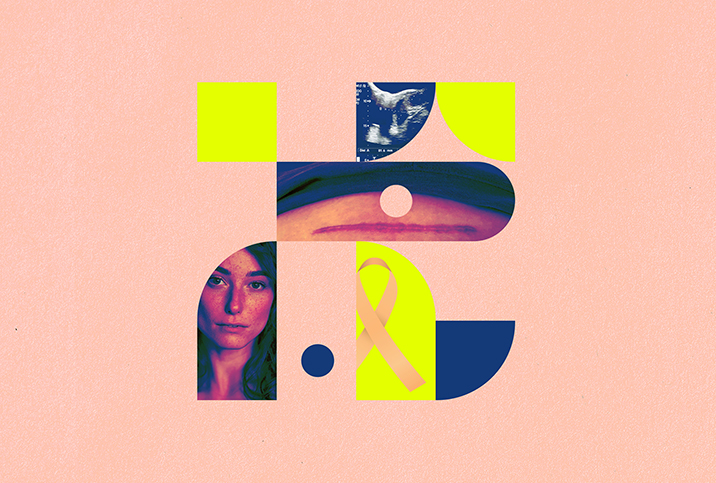Uterine Cancer Deaths Are Increasing, Especially in Black Women

Researchers at the National Cancer Institute (NCI) have uncovered grim findings in a new study about uterine cancer: Deaths from this type of cancer are on the rise, particularly in Black women.
Uterine cancer deaths for women in all racial and ethnic groups increased 1.8 percent per year from 2010 to 2017, the study found. Deaths from non-endometrioid uterine cancer—the more aggressive type—rose 2.7 percent per year, and endometrioid cancer death rates remained stable during this same seven-year period.
"We noted profound disparities by race," said NCI's Megan Clarke, Ph.D., M.H.S., an Earl Stadtman investigator in Washington, D.C., and lead author of the study. "Black women were twice as likely to die of uterine cancer overall and of non-endometrioid subtypes compared to other racial and ethnic groups. Hispanic women had the fastest increase in mortality rates from aggressive non-endometrioid subtypes [6.7 percent], followed by Black [3.5 percent], Asian [3.4 percent] and white [1.5 percent] women."
The known and unknown about uterine cancer
Uterine cancer is the most common gynecologic cancer, typically occurring in people ages 50 and older, according to data from the Centers for Disease Control and Prevention (CDC). An estimated 66,000 new cases of uterine cancer are expected to be diagnosed in 2022 in the United States.
Uterine cancer is detected through an endometrial biopsy or transvaginal ultrasound, usually after symptoms have begun: unusually heavy or long-lasting vaginal bleeding, bleeding after periods have stopped, or pelvic pain or pressure. An annual Pap test can screen for cervical cancer, but it won't show signs of uterine cancer.
Risk factors for uterine cancer aren't well-established, which can hinder physicians' attempts at educating their patients about prevention. It's estimated about 70 percent of uterine cancers may be preventable by maintaining a healthy weight and exercising regularly, said Rebecca Siegel, M.P.H., senior scientific director of surveillance research for the American Cancer Society in Atlanta. Other risk factors for endometrioid uterine cancer—the more common subtype—are genetic predisposition, estrogen-only hormone replacement therapy (HRT) and use of the drug tamoxifen, an estrogen modulator used to treat breast cancer.
'Uterine cancer is one of the only cancers that is increasing in mortality in the U.S.'
Endometrioid tumors account for most of the cases of uterine cancer: 75 percent overall, 78 percent in white women and 53 percent in Black women. This subtype has a good prognosis and is strongly associated with obesity and uterine exposure to estrogen, Siegel said.
Non-endometrioid uterine cancer is more aggressive, has a worse prognosis and is less estrogen-dependent, she added. Eighteen percent of uterine cancer cases fall into this category, with a much higher occurrence rate in Black women (35 percent) than white women (16 percent). This subtype is more deadly—and less is understood about it.
"There is little known about risk factors for non-endometrioid cancers," Siegel said. "Although risk increases with higher body weight, it is not as strong a risk factor as it is for more common, less aggressive subtypes of uterine cancer."
Why are deaths from uterine cancer increasing?
"Uterine cancer is one of the only cancers that is increasing in mortality in the U.S.," Clarke said.
Siegel echoed Clarke's sentiments: "Despite substantial progress against almost every other type of cancer, there has been little to no improvement in clinical management of uterine cancer in the past 40 years, as evidenced by the lack of increase in survival rates."
Particular attention should be paid to the sharp rise in non-endometrioid cancer deaths, Clarke said.
"Physicians should be aware that both the incidence rate and the mortality rate of non-endometrioid cancers are on the rise," she said. "Because these subtypes are rarer than endometrioid uterine cancers, physicians may be less familiar with diagnosing and treating these aggressive types of cancer."
Why are Black women disproportionately affected?
While Clarke said the research was unable to pinpoint a definitive reason for the racial disparities highlighted in the study, it appears to be multifactorial. Black women have higher mortality rates, in part, due to a higher incidence of more advanced, more aggressive tumors. But Clarke added that Black women in the study who had early-stage, less aggressive uterine cancer also had the highest mortality rates.
"Unequal treatment and receipt of high-quality care among Black women compared with white women have been demonstrated to contribute to racial disparities in uterine cancer outcomes," Clarke said.
Other factors also need to be more robustly explored to understand how they may influence racial disparities. These factors include patient comorbidities, patient and provider communication, provider bias, discrimination and structural racism, and potential biological differences in treatment responses, she added.
"While progress has been made toward reducing racial disparities in cancer death rates among Black individuals, we have not seen this same progress for uterine cancer, which has one of the largest racial disparities for any cancer type," Clarke said.
More research is crucial
A commitment to more research for uterine cancer is needed, especially in populations that are most at risk for the more aggressive, deadly subtypes of the disease, said both Clarke and Siegel. Further study would aid the development of effective risk assessments and prevention and treatment strategies.
However, research can't happen without funding. In 2018, NCI funding for uterine cancer was just one-seventh of the funding for ovarian cancer, despite a comparable number of deaths, according to a 2022 research letter Siegel co-authored.
"Funding for uterine cancer research must be increased if there is to be any headway made for this disease," she said.


















